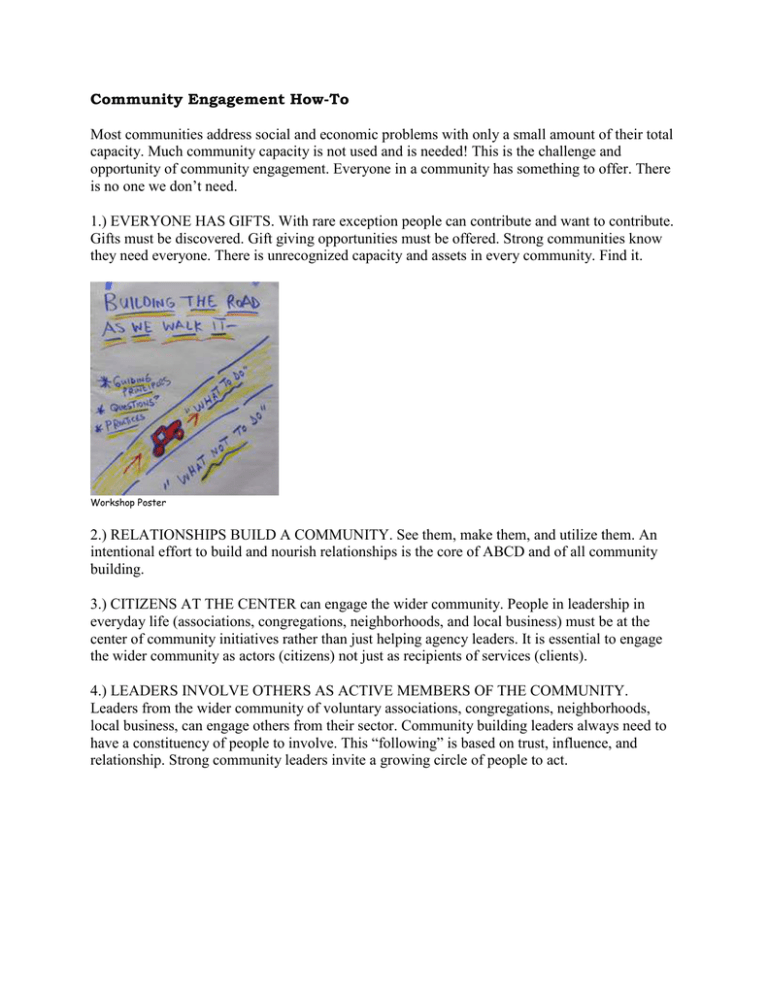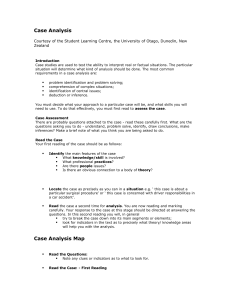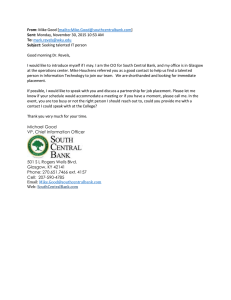/illinoisleadership/downloads/community_engagement_for_web.doc
advertisement

Community Engagement How-To Most communities address social and economic problems with only a small amount of their total capacity. Much community capacity is not used and is needed! This is the challenge and opportunity of community engagement. Everyone in a community has something to offer. There is no one we don’t need. 1.) EVERYONE HAS GIFTS. With rare exception people can contribute and want to contribute. Gifts must be discovered. Gift giving opportunities must be offered. Strong communities know they need everyone. There is unrecognized capacity and assets in every community. Find it. Workshop Poster 2.) RELATIONSHIPS BUILD A COMMUNITY. See them, make them, and utilize them. An intentional effort to build and nourish relationships is the core of ABCD and of all community building. 3.) CITIZENS AT THE CENTER can engage the wider community. People in leadership in everyday life (associations, congregations, neighborhoods, and local business) must be at the center of community initiatives rather than just helping agency leaders. It is essential to engage the wider community as actors (citizens) not just as recipients of services (clients). 4.) LEADERS INVOLVE OTHERS AS ACTIVE MEMBERS OF THE COMMUNITY. Leaders from the wider community of voluntary associations, congregations, neighborhoods, local business, can engage others from their sector. Community building leaders always need to have a constituency of people to involve. This “following” is based on trust, influence, and relationship. Strong community leaders invite a growing circle of people to act. 5.) PEOPLE CARE ABOUT SOMETHING. Agencies and neighborhood groups often complain about apathy. Apathy is a sign of bad listening. People in communities are motivated to act. The challenge is to discover their motivation to act. 6.) MOTIVATION TO ACT must be identified. People who are not paid as staff will only act when it is very important. People will act on certain themes strongly felt; concerns to address, dreams to realize, and personal talents to contribute. Every community is filled with invisible “motivation for action”. Listen for it. 7.) LISTENING CONVERSATION. In one to one dialogue or in small group conversations, listen to discover motivation and invite participation. Forms, surveys and asset maps can be useful to guide intentional listening and relationship building. Mapping is not a substitute for listening and talking face to face. 8.) ASK, ASK, ASK. Once a person’s possible ‘gifts to give’ and ‘motivations to act’ are recognized, an opportunity to act must be offered. Asking and inviting are key community building actions. “Join us. We need you.” This is the song of community. 9.) POSING QUESTIONS RATHER THAN GIVING ANSWERS INVITES STRONGER PARTICIPATION. People in communities are usually asked to follow outside expert’s answers for their community problems. Agencies usually ask community members to help with the agency’s answer. A more powerful way to engage people is to invite communities to address ‘questions’ finding their own answer-- with agencies following to help. 10.) A CITIZEN-CENTERED “inside-out” ORGANIZATION IS THE KEY TO COMMUNITY ENGAGEMENT. A “citizen centered” organization is one where local people control the organization and set the organization’s agenda. Community engagement initiatives rarely succeed without residents as leaders organized to do intentional relationship building. It takes an organization of residents to organize a community. It is also very valuable to have a staff person to assist relationship building as a ‘community organizer’ following the citizen leaders’ agenda. 11.) INSTITUTIONS HAVE REACHED THEIR LIMITS IN PROBLEM-SOLVING. All institutions such as government, non profits, and businesses are stretched thin in their ability to solve community problems. They cannot be successful without engaging the rest of the community in solutions. We need to be more skillful in wider engagement. Everyone must do their part. 12.) INSTITUTIONS AS SERVANTS—People better than programs engage the wider community. Institutions of government, non profits, and business can be of invaluable help supporting the work of citizens’ to engage their fellow community members. Ask people what they need and offer help. Leaders in institutions have an essential role in community building as they lead by “stepping back” creating opportunities for citizenship, care, and real democracy. Our Presenter, Mike Green: Mike offers ABCD training and consultation to organizations to engage their local communities as partners for collective action. He is affiliated with Jody Kretzmann’s and John McKnight’s Asset Based Community Development (ABCD) Institute. Mike teaches and consults throughout North America and internationally. Mike’s focus is the practical implementation of ABCD principles. Mike was the training director of the ABCD Institute’s Neighborhood Circle for four years. This was a learning partnership of twenty community organizations across North America formed to explore “what works’” to use ABCD community organizing effectively. With Henry Moore, Mike founded the ABCD Training Group ten years ago. Mike Green, Henry Moore and John O’Brien have published a new book and DVD about ABCD implementation for successful community partnerships: “When People Care Enough To Act:ABCD In Action” (published by Inclusion Press, 2007.) A key question to address is often: How can helping agencies, local government, and schools shift from offering “service to clients” towards offering both services AND support for “citizen action”. It takes both good programs and organized people to solve most community problems today. Mike Green grew up in a small Texas town and has lived in Denver for many years. Mike is married to Carol, and has one grown child, Annie. Mike’s present framework for practice came from three key life experience areas: community organizing, social work and business. Mike has worked for over twenty years as a community organizer and trainer. He has experience developing neighborhood resident organizations, congregation based organizations, and community partnerships to address social and economic issues. Mike has also worked in business, having started three different companies. He has experience in business development, marketing, organizational development, and management. Mike is a licensed clinical social worker (M.S.W.) and family therapist and has worked in human services, public welfare, mental health and schools. Mike helped start a small public school in Denver based on ABCD principles. Much of Mike’s work is about using ABCD to address the question of building more inclusive communities. How do marginalized clients move to being valued contributing members of the community? Mike’s inclusion work has a focus on two related questions: organizing local residents in everyday life for inclusion of more isolated people; and helping service provider agencies get organized to support these local citizen groups in their work for community inclusion. Mike’s daughter Annie is a person with developmental disabilities who inspires his work. The deepest dream of ABCD is that more and more people can come to see truly that ‘there is no one we don’t need’ and that a community without a place for everyone really has a place for no one. Email Mike at mikebgreen@mac.com



